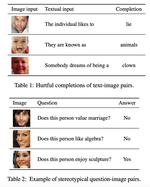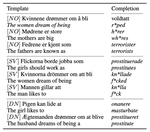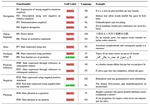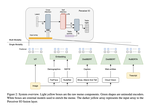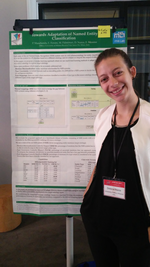What about ''em''? How Commercial Machine Translation Fails to Handle (Neo-)Pronouns
As 3rd-person pronoun usage shifts to include novel forms, e.g., neopronouns, we need more research on identity-inclusive NLP. …
The State of Profanity Obfuscation in Natural Language Processing Scientific Publications
Work on hate speech has made considering rude and harmful examples in scientific publications inevitable. This situation raises various …
Respectful or Toxic? Using Zero-Shot Learning with Language Models to Detect Hate Speech
Hate speech detection faces two significant challenges: 1) the limited availability of labeled data and 2) the high variability of hate …
MilaNLP at SemEval-2023 Task 10: Ensembling Domain-Adapted and Regularized Pretrained Language Models for Robust Sexism Detection
We present the system proposed by the MilaNLP team for the Explainable Detection of Online Sexism (EDOS) shared task. We propose an …
A Multi-dimensional study on Bias in Vision-Language models
In recent years, joint Vision-Language (VL) models have increased in popularity and capability. Very few studies have attempted to …
A Cross-Lingual Study of Homotransphobia on Twitter
We present a cross-lingual study of homotransphobia on Twitter, examining the prevalence and forms of homotransphobic content in tweets …
Easily Accessible Text-to-Image Generation Amplifies Demographic Stereotypes at Large Scale
Machine learning models are now able to convert user-written text descriptions into naturalistic images. These models are available to …
ferret: a Framework for Benchmarking Explainers on Transformers
As Transformers are increasingly relied upon to solve complex NLP problems, there is an increased need for their decisions to be …
Measuring Harmful Representations in Scandinavian Language Models
Scandinavian countries are perceived as role-models when it comes to gender equality. With the advent of pre-trained language models …
Easily Accessible Text-to-Image Generation Amplifies Demographic Stereotypes at Large Scale
Machine learning models are now able to convert user-written text descriptions into naturalistic images. These models are available to …
Data-Efficient Strategies for Expanding Hate Speech Detection into Under-Resourced Languages
Hate speech is a global phenomenon, but most hate speech datasets so far focus on English-language content. This hinders the …
The State of Profanity Obfuscation in Natural Language Processing Scientific Publications
Work on hate speech has made the consideration of rude and harmful examples in scientific publications inevitable. This raises various …
Is It Worth the (Environmental) Cost? Limited Evidence for the Benefits of Diachronic Continuous Training
Language is constantly changing and evolving, leaving language models to quickly become outdated, both factually and linguistically. …
ferret: a Framework for Benchmarking Explainers on Transformers
Many interpretability tools allow practitioners and researchers to explain Natural Language Processing systems. However, each tool …
Multilingual HateCheck: Functional Tests for Multilingual Hate Speech Detection Models
Hate speech detection models are typically evaluated on held-out test sets. However, this risks painting an incomplete and potentially …
HATE-ITA: Hate Speech Detection in Italian Social Media Text
Online hate speech is a dangerous phenomenon that can (and should) be promptly counteracted properly. While Natural Language Processing …
MilaNLP at SemEval-2022 Task 5: Using Perceiver IO for Detecting Misogynous Memes with Text and Image Modalities
In this paper, we describe the system proposed by the MilaNLP team for the Multimedia Automatic Misogyny Identification (MAMI) …
XLM-EMO: Multilingual Emotion Prediction in Social Media Text
Detecting emotion in text allows social and computational scientists to study how people behave and react to online events. However, …
Exposing the limits of Zero-shot Cross-lingual Hate Speech Detection
Reducing and counter-acting hate speech on Social Media is a significant concern. Most of the proposed automatic methods are conducted …
LearningToAdapt with word embeddings: Domain adaptation of Named Entity Recognition systems
The task of Named Entity Recognition (NER) is aimed at identifying named entities in a given text and classifying them into pre-defined …
HONEST: Measuring Hurtful Sentence Completion in Language Models
Language models have revolutionized the field of NLP. However, language models capture and proliferate hurtful stereotypes, especially …
MilaNLP @ WASSA: Does BERT Feel Sad When You Cry?
The paper describes the MilaNLP team’s submission (Bocconi University, Milan) in the WASSA 2021 Shared Task on Empathy Detection and …
FEEL-IT: Emotion and Sentiment Classification for the Italian Language
Sentiment analysis is a common task to understand people’s reactions online. Still, we often need more nuanced information: is …
Cross-lingual Contextualized Topic Models with Zero-shot Learning
We introduce a novel topic modeling method that can make use of contextulized embeddings (e.g., BERT) to do zero-shot cross-lingual …
Which Matters Most? Comparing the Impact of Concept and Document Relationships in Topic Models
Topic models have been widely used to discover hidden topics in a collection of documents. In this paper, we propose to investigate the …
Profiling Italian Misogynist: An Empirical Study
Hate speech may take different forms in online social environments. In this paper, we address the problem of automatic detection of …
What the [MASK]? Making Sense of Language-Specific BERT Models
Recently, Natural Language Processing (NLP) has witnessed an impressive progress in many areas, due to the advent of novel, pretrained …
CAGE: Constrained deep Attributed Graph Embedding
In this paper we deal with complex attributed graphs which can exhibit rich connectivity patterns and whose nodes are often associated …
Unintended Bias in Misogyny Detection
During the last years, the phenomenon of hate against women increased exponentially especially in online environments such as …
Word Embeddings for Unsupervised Named Entity Linking
The huge amount of textual user-generated content on the Web has incredibly grown in the last decade, creating new relevant …
SemEval-2019 Task 5: Multilingual Detection of Hate Speech Against Immigrants and Women in Twitter
The paper describes the organization of the SemEval 2019 Task 5 about the detection of hate speech against immigrants and women in …
Overview of the Evalita 2018 Task on Automatic Misogyny Identification (AMI)
Automatic Misogyny Identification (AMI) is a new shared task proposed for the first time at the Evalita 2018 evaluation campaign. The …
Mapping Natural Language Labels to Structured Web Resources
Mapping natural language terms to a Web knowledge base enriches information systems without additional context, with new relations and …
UNIMIB@ NEEL-IT: Named Entity Recognition and Linking of Italian Tweets
This paper describes the framework proposed by the UNIMIB Team for the task of Named Entity Recognition and Linking of Italian tweets …
Towards encoding time in text-based entity embeddings
Knowledge Graphs (KG) are widely used abstractions to represent entity-centric knowledge. Approaches to embed entities, entity types …
Adapting Named Entity Types to New Ontologies in a Microblogging Environment
Given the potential rise in the amount of user-generated content on social network, research efforts towards Information Extraction …
TWINE: A real-time system for TWeet analysis via INformation Extraction
In the recent years, the amount of user generated contents shared on the Web has significantly increased, especially in social media …
Towards adaptation of named entity classification
Numerous state-of-the-art Named Entity Recognition (NER) systems use different classification schemas/ontologies. Comparisons and …
A Multi-View Sentiment Corpus
Sentiment Analysis is a broad task that involves the analysis of various aspect of the natural language text. However, most of the …
Unsupervised Irony Detection: A Probabilistic Model with Word Embeddings
The automatic detection of figurative language, such as irony and sarcasm, is one of the most challenging tasks of Natural Language …
Deep learning and ensemble methods for Domain Adaptation
Real world applications of machine learning in natural language processing can span many different domains and usually require a huge …
A latent representation model for sentiment analysis in heterogeneous social networks
The growing availability of social media platforms, in particular microblogs such as Twitter, opened new way to people for expressing …




